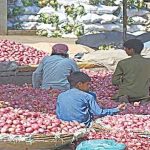ISLAMABAD: During 2023–24, Pakistan’s GDP and per capita income grew in US dollars, suggesting a resurgence in the nation’s overall output in comparison to the previous year.
The economy is still less than the $375.449 billion recorded in FY22, though, suggesting that the coalition government led by the PMLN has slowed GDP growth. On Wednesday, under the direction of Planning Commission Secretary Awais Manzur Sumra, the National Accounts Committee (NAC) accepted these data.
The GDP increased from $338.150 billion in FY23 to $374.903 billion in FY24. The increase suggests that the nation’s historically high inflation is the main driver of growth.
The committee approved the 6.18 percent final annual GDP growth for FY22, which represents a sharp increase under the PTI administration. Growth then continued to fall until the prior year, at which point it started to increase in the current fiscal year.
According to NAC, these numbers remain below the level of FY22.
stagnant earnings
In FY24, the per capita income rose little from $1,551 to $1,680. But in FY22 and FY21, it was $1,766 and $1,677, respectively. This implies that, despite no discernible rise in personal incomes, practically every component of society’s level of living and well-being is declining.
It might result in a drop in disposable income, which would make it harder for people to save money, invest, or buy products and services.
The third quarter of FY24 had 2.09 percent growth in the GDP. A robust increase in especially significant crops allowed the agriculture sector to grow at a rate of 3.94 percent in comparison with the same quarter last year.
Due to a rise in wheat production, important crops experienced a 2.89 percent growth in Q3. Now, wheat is calculated using the initial estimate of production, which is 31.44 million tons, as reported by provincial crop reporting services. Previously, wheat was estimated based on area and indicated a rise of 6.7pc.
The increase in wheat has led to an improvement in the projections for Q1 and Q2, as well as an increase in the annual benchmark for the year 2023–2024. Other crops have also grown reasonably well, up 1.14 percent from the third quarter of last year’s -0.99 percent. A rise in the production of fruits and vegetables is the cause of this growth. The amount of livestock is the same, and growth in forestry and fishing has remained consistent.
Following Q1 of this year, the industry is emerging from a negative growth zone and has begun to show signs of recovery in Q3. Following three quarters of negative growth in 2022–2023 and the first quarter of 2023–2024, the industry is showing signs of improvement in the revised Q2 and Q3 of 2023–2024, with growth rates of 3.84 percent and 0.09 percent, respectively. The services sector grew by 0.83 percent in the third quarter of 2023–2024. An internal investigation of the sector shows a contradictory pattern.








